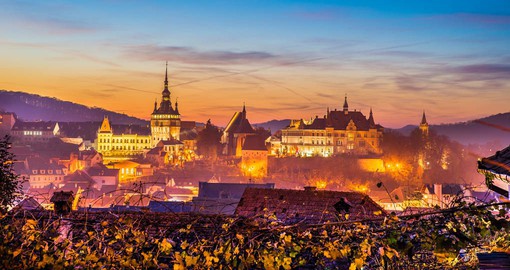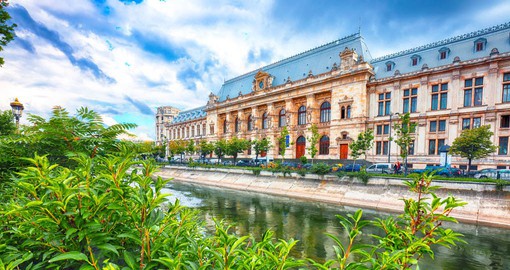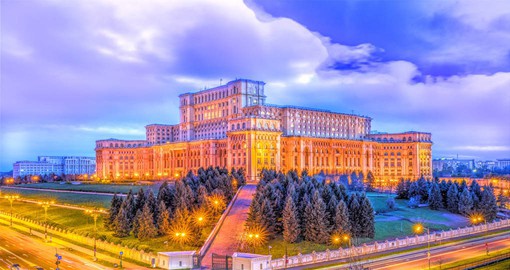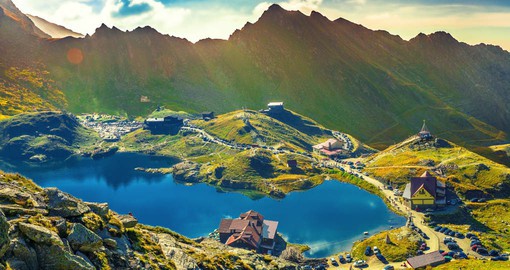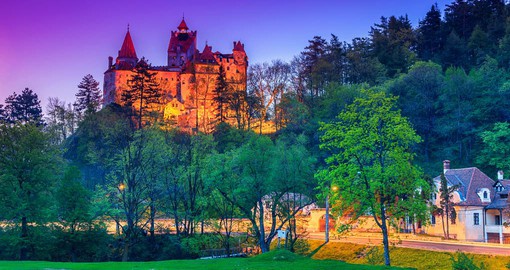Highlights of Bucharest and Brasov
- Duration
- 7 Days
- Prices From:
- AU$ 3,360
FIRST-CLASS | PRIVATE-GUIDED: On this delightful week in Romania you'll discover the country's history, travel along one of the world's most scenic roads, visit stunning Sighisoara, and - saving the best for last - enjoy a private tour of Bran Castle by night including dinner and wine.
Get a taste of a truly fascinating country on this 7-day Romania tour from Bucharest. Travel back to the sobering communist years, and visit some of the country’s most picturesque villages, along with a few ghoulish legends of folklore.
Your adventure begins in Bucharest, where one of Europe’s least understood capitals boasts one of its most astonishing architectural icons. The Palace of Parliament, a holdover from the turbulent communist era, seems almost too grand to be real. Learn about the times that surrounded its creation, and the revolution that brought that regime to an end before visiting the Spring Palace, the last residence of the dictator Nicolae Ceasescu.
Take a privately guided road trip along the Transfagarasan, including historic Curtea de Arges, and a drive-by Poenari Castle. Currently, under renovation, Poenari’s claim to ‘Dracula’ lineage has more credibility than the more famous Bran Castle, which you’ll visit later in the trip. A major highlight of this day however is the road itself, which showcases the immense beauty of the Carpathians.
The following day, transfer to Brasov, your base for exploring the Transylvania region. Much more than a cradle of spooky legends, this beautiful part of the world is dotted with Saxon villages including UNESCO-listed Sighisoara, the birthplace of Vlad Tepes, the infamous ‘Impaler.’ You’ll learn a lot more about the truths and myths that surround this legendary figure as you explore the region.
Your last full day here takes you to some of Transylvania’s hidden treasures, along with one of its best-known sights. Uncover the history of Brasov itself, including one of Europe’s oldest working watermills. Then dive into the mysterious caves of Sinca Veche, thought to be 7,000 years old, with many exciting stories spanning its history. Visit the magnificently preserved Fagaras Fortress, before returning to your hotel.
Then, a very special experience awaits as you enjoy a lantern-led private tour of Bran Castle. As we already mentioned, Bran’s links to Vlad Tepes are tenuous at best. Bran’s claim to being ‘Dracula’s Castle’ can be traced to Bram Stoker having drawn inspiration from it while describing the vampire’s imposing home in his novel. It remains an atmospheric experience, sure to spook and delight! Afterwards, sit down for a dinner composed of delicious traditional dishes made from local ingredients.
Of course, there are options if you never drink... wine.
- Duration
- 7 Days
- Prices From:
- AU$ 3,360
Itinerary View Trip Map
Bucharest Airport to Bucharest Hotels
| Duration | 3 Hours |
|---|
Hotel Duke
In a central location in Bucharest, steps away from the Romana Square, the Hotel Duke Romana offers accommodation within easy reach from the main landmarks of the city. The historic Victoriei Avenue is just 420 yards away, while the Romanian Athenaeum, the Victoriei Square and the Cismigiu Gardens are all within 1 km from the hotel. It's just about 2 km to Bucharest's Old and Henri Coanda Airport is an easy 30-minute drive. The public spaces are contemporary in style and airy, while rooms are comfortable, nicely appointed and offering all the amenities expected by today's traveler. This is a good choice for travelers of all ages, including families, looking for moderately priced accommodation in a central location.
| Meal Plan | Buffet Breakfast |
|---|---|
| Duration | 3 Nights |
| Accommodation |
Hotel Duke |
| Location | View map |
-
Hotel Duke
In a central location in Bucharest, steps away from the Romana Square, the Hotel Duke Romana offers accommodation within easy reach from the main landmarks of the city. The historic Victoriei Avenue is just 420 yards away, while the Romanian Athenaeum, the Victoriei Square and …
In a central location in Bucharest, steps away from the Romana Square, the Hotel Duke Romana offers accommodation within easy reach from the main landmarks of the city. The historic Victoriei Avenue is just 420 yards away, while the Romanian Athenaeum, the Victoriei Square and the Cismigiu Gardens are all within 1 km from the hotel. It's just about 2 km to Bucharest's Old and Henri Coanda Airport is an easy 30-minute drive. The public spaces are contemporary in style and airy, while rooms are comfortable, nicely appointed and offering all the amenities expected by today's traveler. This is a good choice for travelers of all ages, including families, looking for moderately priced accommodation in a central location.
Facilities
- Bar
- Business Centre
- Car Rental Service
- Free Parking
- Laundry Service
- Luggage Service
- Room Service Limited Hours
- Travel Service
- WiFi
Photo gallery
Photo 1 of 4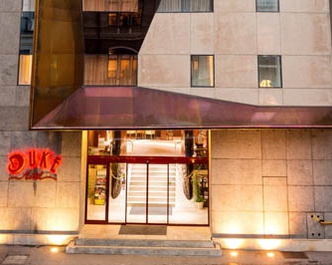
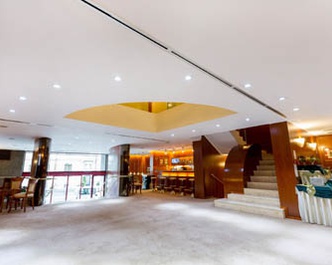
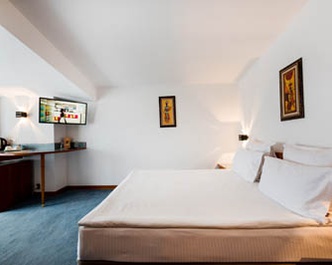
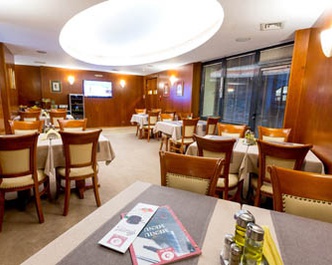
Private Bucharest Communist Era Tour
Former communist leader Nicolae Ceausescu led Romania through some of its darkest times in history. Marks of his cruel regime are still visible in Romania's capital, Bucharest, today and this privately guided tour is a step back in time, offering an interesting, yet stark reminder of how dreams of glory are sometimes built on oppression and manipulation. Your tour begins with a trip to some of the metro stations built under the Ceausescu Regime. What's interesting is that the network was designed totally different from other Eastern European systems. The stations were simple, clean-cut and modern, avoiding fanciful additions such as mosaics, and other excessive decorations. The main objective was speed of transit and practicality, each station and line being assigned a color theme and laid-out in an open plan. Ignoring typical communist-style uniformity, no station was made to look exactly like any other. Despite all this, the city's energy economy in the late 1980s kept many stations quite dark and system modernization has still not managed to totally fix the problem.
To better understand a communist neighbourhood, you'll see places such as Berceni and Bucharest's western district of Drumul Taberei, the latter filled with monotonous slabs of concrete and the deafening sound of drills and car horns in the air. This was Ceausescu's idea of a centrally planned housing project, built especially for the working class. Yet this neighborhood grew initially from a genuine concept centered on the needs of citizens until the regime took over the duties of urban planning and constructed taller and bigger blocks throughout the city. You will have a chance to walk around some of these areas and get a glimpse of some quite amazing street art, rather than mindless graffiti, something that was strictly prohibited during communist rule.
Your next stop and visit could be described as the 'World's ultimate white elephant' and it certainly suggests the pinnacle of megalomania. Ceausescu had 9,000 homes demolished to make way for the Palace of Parliament, originally called the 'House of the Republic'. It was, finally, completed eight year's after his execution in 1989 and became the world's second-largest administrative building after the Pentagon. Because of its weight, it apparently sinks almost a quarter of an inch every year.
After your tour around the 'Palace' a short drive takes you to the Revolution Square where you can enjoy a brief walk around a place that was the starting point of the anti-communist revolution. It was here, on December 21, 1989, that a crowd of over 100,000 people, brought in as was the fashion to cheer Ceausescu, turned the tables by jeering him on live television. It was to be his last public speech and he fled by helicopter from the roof of the building the following morning.
The final stop of your tour visits the Spring Palace, the opulent residence of Nicolae Ceausescu and his wife Elena and since 2016, a museum. The 80-room residence, designed in the mid-1960s to the specifications of the former dictator and his wife, who reportedly personally picked the chandeliers and mosaics, is a Bucharest landmark not to be missed. Upon completing the tour of the residential palace, your communist tour comes to an end and you will be dropped back at your hotel.
| Duration | 8 Hours |
|---|
Private Transfagarasan Road Trip
This privately guided tour introduces you to an interesting piece of Romanian history by visiting Cuerta de Arges, one of its most magnificent cultural highlights, before taking you on a breathtaking journey along one of the country's most exhilarating roads, the Transfagarasan. You'll leave your hotel early in the morning and your first stop is about two hours away. Looking more like a mosque than a typical Orthodox church, the monastery of Curtea de Arges is a historical site and a wonderful example of how art and cultural influences can happily mix to represent the architectural grace of different religious faiths. Built by Wallachian Prince Neagoe Basarab, the consecration ceremony in 1517 was attended by the Patriarch of Constantinople, a testament to its religious importance. Sadly, earthquakes and fires wreaked much destruction on the edifice, and it was not until 1875 that serious reconstruction work commenced. Today it is a necropolis not only for its medieval founders, but also Romania's royal family, with both King Carol I and King Ferdinand I, as well as Queens Elisabeta and Maria buried here. The legend of Master Manole adds a tale of woe associated with the building. Prince Radu the Black hired Manolo and nine of his men to build the most beautiful monastery in the country. Curiously, the newly built walls crumbled every night and the prince threatened to kill the entire crew. One night, clearly desperate, Manolo had a dream suggesting that for the monastery to be built, a person loved by him or his masons would need to be entombed inside the walls. Manolo told his men and they agreed that the first of their wives coming to the castle bringing their lunch would be the human sacrifice. It was Manolo's wife.
Leaving Curtea de Arges behind, your journey takes you up the first part of the splendid highway up the Carpathian Mountains until you pass Poenari Castle, sitting on top of an isolated and eerie cliff, 2,800 feet above ground. Unlike Bran Castle, Poenari can lay claim to being one of the key residences of Vlad Tepes, who repaired and consolidated the original structure back in the 15th century. The fortress is, currently, under renovation and cannot be visited for some time to come.
Shortly afterwards, you'll reach the truly riveting part of the trip. The Transfagarasan, also known as Ceausescu's Folly, is one of the most spectacular roads in the world. It is roughly 90 km (56 miles) long and has more tunnels and viaducts than any other road in Romania. It's been written up in numerous magazines and the well-known British Television motor show Top Gear filmed here in 2009. They were, apparently, highly impressed. It was built between 1970 and 1974 by the military on orders from Nicolae Ceausescu. 6,000 tons of dynamite were used to clear a path for the road on the northern side of the mountains and 40 soldiers, apparently, lost their lives during construction. Many people claim that the loss of life was, actually, in the hundreds. The drive is spectacular, featuring numerous curves and switchbacks that provide brilliant views back from where you started your ascent and you should ask your driver to stop whenever a magic photo opportunity presents itself, which is virtually every two minutes.
You have a chance for lunch (not included) around an area called Valea cu Pesti and from there it's approximately an hour before you reach Balea Lake, a natural wonder in its own right with crystal-clear, icy water surrounded by gorgeous mountain peaks. This is the northernmost point of the trip and you can enjoy some time by the lake or going for a short hike, before you return to Bucharest.
| Duration | 12 Hours |
|---|
Bucharest Hotels to Brasov
| Duration | 3 Hours |
|---|
Hotel Belfort
The Belfort Hotel enjoys a great central location in a tranquil, leafy, area of Brasov, at the foot of Tâmpa Mountain, just off the edge of the forest, yet only a 5-minute walk from the main pedestrian shopping areas of Republicii and the Schei Gate. The Council Square and the Black Church are just a 10-minute walk away. It's a new hotel with lovely airy public spaces, especially the lobby area which is covered by a glass ceiling. The breakfast room offers a delightful panoramic view and the rooms are very well appointed with all the amenities expected by today's travelers. This is a great choice for travelers looking for moderately-priced accommodation that still offers a good location.
| Meal Plan | Buffet Breakfast |
|---|---|
| Duration | 3 Nights |
| Accommodation |
Hotel Belfort |
| Location | View map |
-
Hotel Belfort
The Belfort Hotel enjoys a great central location in a tranquil, leafy, area of Brasov, at the foot of Tâmpa Mountain, just off the edge of the forest, yet only a 5-minute walk from the main pedestrian shopping areas of Republicii and the Schei Gate. …
The Belfort Hotel enjoys a great central location in a tranquil, leafy, area of Brasov, at the foot of Tâmpa Mountain, just off the edge of the forest, yet only a 5-minute walk from the main pedestrian shopping areas of Republicii and the Schei Gate. The Council Square and the Black Church are just a 10-minute walk away. It's a new hotel with lovely airy public spaces, especially the lobby area which is covered by a glass ceiling. The breakfast room offers a delightful panoramic view and the rooms are very well appointed with all the amenities expected by today's travelers. This is a great choice for travelers looking for moderately-priced accommodation that still offers a good location.
Facilities
- 24 Hour Concierge
- Bar/Lounge
- Bike Rental
- Conference Facilities
- Free WiFi
- Laundry Service
- Parking
Photo gallery
Photo 1 of 5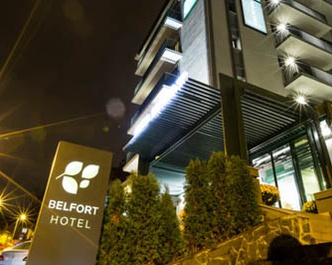
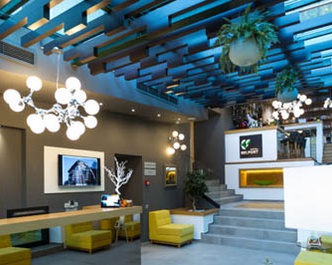
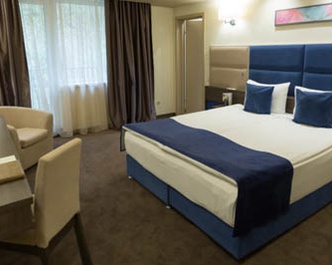
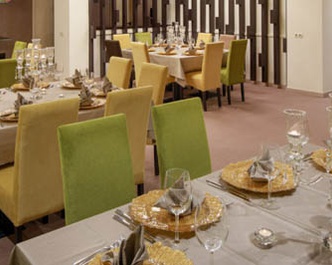
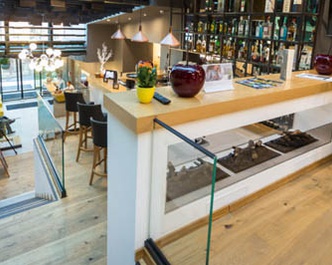
Private Day Trip from Brasov to Sighisoara and Viscri
The highlights of the Saxon villages of Transylvania are yours to discover today. The introduction of Saxon culture to Transylvania dates to 1153 when Hungarian King Geza II recruited mercenaries and craftsmen from what is today's Moselle area, to guard his borders against attacks from foreign invaders. In exchange, they received permanent rights of settlement. During their time, they built almost 200 fortified churches, scattered throughout the southern part Transylvania, Sighişoara, UNESCO-listed for its Historic Centre, and quaint Viscri, which is UNESCO-listed for its fortified church are the two stand-out features on this trip.
After meeting your driver-guide at your hotel, you'll first visit the citadel at Rupea, the focus of a major renovation project and opened to the public in 2013. Historians believe that the fortress was built on old Dacian ruins since archeologist have found pottery, urns and tools from that period. As you approach, you see that it is almost shaped like a snail shell, consisting of three smaller fortresses each one of them built in a different time.
Leaving the citadel, you are now an hour's drive away from a very special place. Does it simply have the best-preserved medieval citadel in Europe, or is it one of the last genuinely medieval towns on the planet? Undoubtedly, Sighişoara is the pearl of Transylvania. The location of its magnificent historic center is on a hill, surrounded by thick, fortified walls and towered over by a gorgeous, bewitching-looking 14th century clock tower. Steps away, on the citadel square, Tin Street No. 1 is an address of serious significance. It is the house where Vlad Dracul and his pregnant wife stayed between 1431-35 and thus the birthplace of another Vlad, namely Vlad Tepes, the Impaler. Today, the ground floor opens to a medieval-style restaurant, while the first floor houses a small weapon museum. The citadel square is a busy place during the summer season with lots of al-fresco restaurants, and here your guide can help you find a suitable place for lunch (not included).
After lunch, head to Viscri is to walk the unpaved roads of a village where time appears to have stood still. Virtually all were built several hundred years ago, the faded colors of window shutters adding their own peculiar charm. Meanwhile, Viscri's famous church continues to keep a protective look down upon the village rooftops.
| Duration | 11 Hours |
|---|
Day Tour from Brasov to the Hidden Gems of Sinca Veche and Fagaras County
Some day trips offer a heady mix of attractions. On this privately guided tour starting in Brasov, you'll visit a couple of man-made ones, one immediately impressive, the other one simple, based on old traditions, yet still amazing. Then, just to shake it up a little, you are going to discover a cave monastery, thought to be 7,000 years old with features carved into its walls some of which are shrouded in mystery to this day. Your driver-guide will stop first at an old water mill, just outside the village of Ohaba. It was originally built in 1873 with mill stones that, allegedly, came from Lyon in France and is still working at full power today. An older gentleman from the village manages today's operation and owns what is, undoubtedly, a serious ethnographic treasure. While a few small changes were made to the mill over time, it still features a large wheel that is driven by the river passing by the mill's yard, and villagers still come here every day to grind grain. Just observing the process, an authentic rural Transylvanian experience, is incredibly interesting.
Just a few minutes down the road, you'll discover a place that is wrapped in mystery. It's a cave complex on the outskirts of the village of Sinca Veche, variously called 'The Monastery', Temple of Destiny' or 'Temple of Fate'. The site is thought to be 7,000 years old and the origin of the original builders is unknown. The complex comprises of nine different rooms, two of which appear to represent separate chapels. A series of low windows and chimney-shaped skylights allow light to enter the cave adding to the overall mystique of the place. Based on an unusual melange of religious symbols carved on different temple walls, suggests that it must have been home to different religious tenants. You'll discover, for example, a Star of David and something that looks like a Chinese yin-yang symbol that could, however, also depict two fish. Another curious factor is the absence of Christian crosses although orthodox monks are rumored to have been hiding here from Habsburg Empress Maria Teresa, who was trying to convert the Orthodox Church to Catholicism. According to another legend, once you go underground you no longer feel any fatigue and, in fact, feel incredibly energized. This is certainly an encouraging benefit while you are on this exciting tour of discovery.
After coming back up from the cave complex, potentially very refreshed, you are 30 minutes away from the last stop on today's trip, the Fagaras Fortress. It is one of Transylvania's most impressive fortifications and still very much intact. The current stone citadel was built in 1310 after the Tartars burned down the original wooden structure and constant improvements and enlargements were made throughout the turbulent times of various rulers. For the longest time its primary function was as a noble residence for the princes and their families and in the 17th century, Prince Gabriel Bethlen brought in Italian architects and glassmakers to add some grace to the pragmatic structure. Unfortunately, little remains of the interior's luxurious, original decor. During the 18th century, the castle was transformed into a military garrison and there was no longer any requirement for opulent interiors, which accounts for these dramatic changes. In 1948 the communists took over, taking it down another notch by turning it into a political prison. What used to be a rich and beautifully decorated place, is now a museum but, thankfully, displaying an amazing array of medieval weapons, traditional folk crafts and a stunning collection of icons painted on glass.
Following a tour around the castle, your driver-guide takes you back to your hotel in Brasov.
| Duration | 5 Hours |
|---|
Private Dracula Castle Tour by Night from Brasov
The idea of having dinner at a dimly lit Bran Castle, well after dark, with no other visitors around, sounds like an intriguing proposition. The atmosphere on this privately guided program will be further enhanced by the castle's 'night-shift', dressed in capes and holding aloft lanterns as they lead you up spiral staircases and along narrow corridors to ensure that you are fully immersed in a medieval experience. This is a great 'behind-the-scenes' tour of the castle, followed by a special dinner in the original Old Tea House of Maria, Queen of Romania. Importantly, though, you should imagine the evening as if you are temporarily on a movie set, playing out scenes for a Count Dracula story. The reason for this is simple: Bran Castle, despite its suggestive looks, is not Dracula's Castle. Although many a myth connect the real Vlad Dracula, more widely known as Vlad Tepes or Vlad the Impaler with Bran, virtually all historians agree that he never set foot in the place. Knowledge of this should, of course, not deter you from enjoying a potentially spooky, vampiric evening.
After the lantern-led tour around the castle, your local guide takes you to Queen Maria's Old Tea House, at the foot of the castle, for a special dinner. Regional cuisine can reveal more about local culture and traditions than a museum and tonight you will enjoy a special dinner and taste some local wine served with some carefully selected dishes. The menu is composed of local products found only in this region and because you are in a legendary place, some unique dessert should remind you of a terrific, but not terrifying, experience. History buffs might be interested to know that the partially ruined castle was offered as a gift to Romania's Queen Maria who restored and modernized the old fortress, transforming it into one of her favorite royal residences. After her death in 1938, the castle was inherited by her favorite daughter, Princess Ileana. She lived here with her family until the end of 1947 when the communists forced her to leave the country. Fast-tracking to 2009, possession of the castle was given to its legal heir, Archduke Dominic von Habsburg, who opened the refurbished castle to the public as the first private museum of the country.
After dinner, and before midnight, you'll return to your hotel in Brasov.
| Duration | 5 Hours |
|---|
Brasov to Bucharest Airport
| Duration | 3 Hours |
|---|
Other Information
DEPARTURES:
Daily
PRICE INCLUDES:
- Private arrival and departure airport transfers
- 3 nights first-class accommodations in Bucharest
- 3 nights first-class accommodations in Brasov
- Private guided Bucharest Communism Era day tour
- Private guided Transfagarasan Road day trip
- Private guided Sighisoara & Viscri day tour
- Private guided tour of Sinca Veche and Fagaras County
- Private guided tour of Bran Castle by Night with Dinner and Wine
- Private transfer from Bucharest to Brasov
- Breakfast daily (excluding day 1)
PRICE EXCLUDES:
- Travel insurance
- International and domestic airfare & airfare taxes
- Visa fees if applicable
- Meals and beverages not mentioned
- Gratuities
- Items of a personal nature
TERMS AND CONDITIONS:
Prices are "from" per person based on twin/double share accommodation and for travel in low season. Seasonal surcharges and blackout dates may apply. Limited seat/spaces and all pricing is subject to change and availability. Rates for single or triple travellers are available on request - please inquire.
21 Aug 2023







